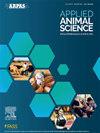Effects of inclusion of urea and wet distillers grains with solubles in diets based on dry-rolled corn on heifer performance and carcass characteristics
IF 1.5
Q3 AGRICULTURE, DAIRY & ANIMAL SCIENCE
引用次数: 0
Abstract
Objectives
The objective of this study was to evaluate the effects of urea and wet distillers grains with solubles (WDGS) inclusion on heifer growth performance and carcass characteristics.
Materials and Methods
Crossbred heifers (n = 96) were used to study the effects of 2 inclusion levels of both WDGS and urea in a finishing diet based on dry-rolled corn on performance and carcass characteristics. Heifers were individually fed using a Calan gate system with a 2 × 2 factorial arrangement of treatments. Factors were inclusion of WDGS at either 10% or 20% of diet DM and dietary urea at a concentration of either 0.2% or 1.2% DM basis. Cattle were stratified by BW and assigned randomly to treatment. Blood samples were collected at 3 time points during the feeding period and analyzed for plasma urea nitrogen content. The statistical model included urea and WDGS inclusions and their interactions as fixed effects.
Results and Discussion
There were no interactions between WDGS and urea inclusion for any performance or carcass characteristics, so only main effects are discussed. There were no differences for final BW, ADG, and G:F on a live or carcass-adjusted basis for either urea or WDGS inclusion in the diet. Dry matter intake was less with increased urea inclusion; however, WDGS inclusion did not influence DMI. No differences were observed for any carcass characteristics because of urea or WDGS inclusion. Plasma urea nitrogen was greater for cattle as either urea or WDGS inclusion increased.
Implications and Applications
These data would suggest that when feeding diets based on dry-rolled corn, adding urea beyond that of the 0.2% treatment is not necessary when at least 10% WDGS is included in the diet
干滚玉米日粮中添加尿素和湿酒糟及可溶物对犊牛生产性能和胴体特性的影响
目的研究尿素和湿酒糟混溶物(WDGS)对犊牛生长性能和胴体性状的影响。材料与方法以96头杂交小母牛为试验对象,研究干滚玉米育肥期饲粮中添加2种水平WDGS和尿素对生产性能和胴体性状的影响。小母牛采用卡兰门饲喂,2 × 2因子处理。影响因素包括:在饲粮中添加10%或20%日干物质的WDGS,在饲粮中添加0.2%或1.2%日干物质的尿素。按牛体重分层,随机分配处理。在饲养期内的3个时间点采集血液,分析血浆尿素氮含量。统计模型包括尿素和WDGS包裹体及其相互作用作为固定效应。结果与讨论WDGS与尿素包合物之间没有相互作用,因此只讨论了主要影响。无论在饲料中添加尿素还是WDGS,在活体或胴体调整的基础上,最终体重、平均日增重和G:F均无差异。干物质采食量随尿素包裹量的增加而减少;然而,WDGS的加入对DMI没有影响。未观察到尿素或WDGS对任何胴体特性的影响。血浆尿素氮随尿素或WDGS含量的增加而增加。这些数据表明,当饲粮中WDGS含量至少为10%时,在以干轧玉米为基础的饲粮中,无需在0.2%处理基础上添加尿素
本文章由计算机程序翻译,如有差异,请以英文原文为准。
求助全文
约1分钟内获得全文
求助全文

 求助内容:
求助内容: 应助结果提醒方式:
应助结果提醒方式:


